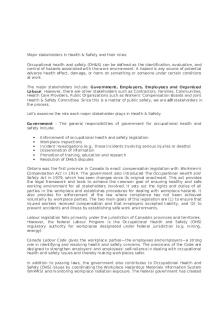Who are the main stakeholders in Marks and Spencer PDF

| Title | Who are the main stakeholders in Marks and Spencer |
|---|---|
| Course | Strategic Financial Management |
| Institution | University of South Wales |
| Pages | 2 |
| File Size | 75.4 KB |
| File Type | |
| Total Downloads | 111 |
| Total Views | 154 |
Summary
Download Who are the main stakeholders in Marks and Spencer PDF
Description
Who are the main stakeholders in Marks and Spencer? What are the main objectives of each and to what extent are they consistent? This paper sets out to look into different stakeholders of Marks and Spencer and their objective in terms what extent are they consistent. Stakeholders are any group or individuals who can affect or are affected by the achievement of the organization’s objectives (Freeman, 2010). Bryson (1995) defines stakeholders as any persons, group or organization that can place a claim on an organization’s attention, resources or output or are affected by that output. Marks and Spencer’s stakeholders are their employees, customers, shareholders and investors, suppliers, local communities, government and pressure groups. Some of these stakeholders are internal and others are external to the organization. 1. Employees- Marks and Spencer has over 70000 employees who devote their time working for the organization in order to earn a source of their livelihood (Marksandspencer Annual Report , 2019). Employees will demand fair treatment, job security, benefits, good pay, good working environment and protection from abuse. Employees directly influence the profits of the organization since they are the ones involved in the day to day operations. Marks and Spencer have independent internal hotlines and they conduct activities that involve employees’ participation as part of engaging their employees. 2. Customers-they are critical stakeholders for Marks and Spencer because they are the buyers of the company’s products. Customers will want high quality products and services with wide range and variety of products and choices at an affordable price. Marks and Spencer monitor the movement of their products through sales and they are able to predict customer needs based on sales records. Through their Retail Customer Services, they are able to contact customers, conduct surveys to discover customer needs and preferences and provide feedback to customers. 3. The local and national government set laws and regulations that govern trading and how Marks and Spencer should act and deal with people in the organization. They ensure that the company adheres to the laws such as company’s acts, health and safety regulations and other customs. The government also makes sure that the company is able to create more jobs for the citizens and also pays taxes to the government. Marks and Spencer conduct meetings with the government, dialogues with trade bodies, stakeholder conferences and provides responses to consultations. 4. Suppliers- they are companies that provides goods or raw materials to the company. Marks and Spencer suppliers are globally and these need secure contracts and fair prices for their products and services. The influence of suppliers depends on their relative size and the number of available suppliers. 5. Shareholders and Investors- these are groups or individuals who have invested in the company through buying of shares or injecting cash in business during the tough times. They are interested in the growth of the company and making sure that the company is able to make profits. Investors will pressure the management
if things are not going well and request management to change their tactics in order to remain productive. Marks and Spencer conducts annual general meetings, meetings with institutional investors and SRI indexes and information requests as a way of keeping investors and shareholders updated. 6. Local communities- the community provides customer base through which sales are conducted. They can determine whether a store should be situated in the area or not and can tarnish the company reputation if they are not properly informed. Marks and Spencer maintains the good relationship with the community through visits and meetings, joint projects and stakeholder conferences among others. References Bryson, J. M., 1995. Strategic Planning for Public and Non-profit Organization. Revised ed. San Francisco: Jossey-Bass. Freeman, E. R., 2010. Strategic Management: A stakeholder Approach. New York: Cambridge University Press. Marksandspencer Annual Report , 2019. Marks and Spencer. [Online] Available at: corporate.marksspencer.com [Accessed 18 September 2020]....
Similar Free PDFs

Marks and spencer
- 2 Pages

Marks-spencer-y-zara compress
- 4 Pages

Marketing plan for Marks & Spencer
- 11 Pages

Who are Generation Z essay
- 1 Pages

Stakeholders
- 1 Pages

stakeholders and governance
- 3 Pages
Popular Institutions
- Tinajero National High School - Annex
- Politeknik Caltex Riau
- Yokohama City University
- SGT University
- University of Al-Qadisiyah
- Divine Word College of Vigan
- Techniek College Rotterdam
- Universidade de Santiago
- Universiti Teknologi MARA Cawangan Johor Kampus Pasir Gudang
- Poltekkes Kemenkes Yogyakarta
- Baguio City National High School
- Colegio san marcos
- preparatoria uno
- Centro de Bachillerato Tecnológico Industrial y de Servicios No. 107
- Dalian Maritime University
- Quang Trung Secondary School
- Colegio Tecnológico en Informática
- Corporación Regional de Educación Superior
- Grupo CEDVA
- Dar Al Uloom University
- Centro de Estudios Preuniversitarios de la Universidad Nacional de Ingeniería
- 上智大学
- Aakash International School, Nuna Majara
- San Felipe Neri Catholic School
- Kang Chiao International School - New Taipei City
- Misamis Occidental National High School
- Institución Educativa Escuela Normal Juan Ladrilleros
- Kolehiyo ng Pantukan
- Batanes State College
- Instituto Continental
- Sekolah Menengah Kejuruan Kesehatan Kaltara (Tarakan)
- Colegio de La Inmaculada Concepcion - Cebu









